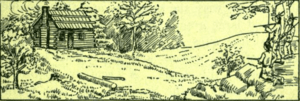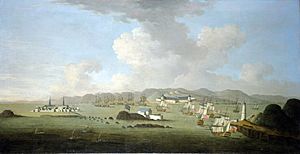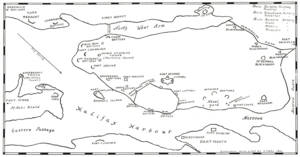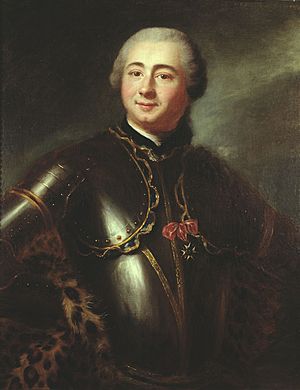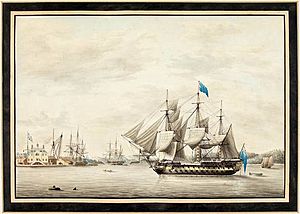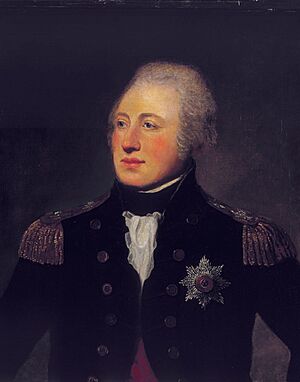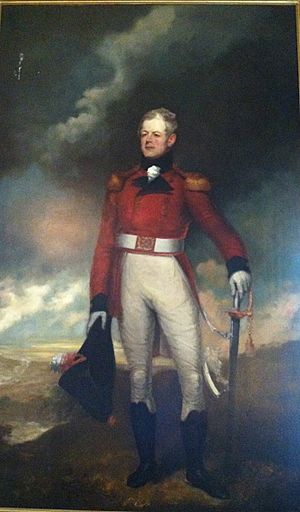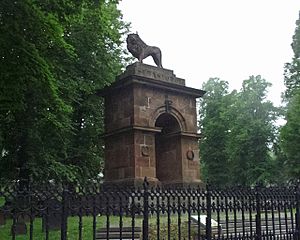Military history of Nova Scotia facts for kids
Nova Scotia, also known as Mi'kma'ki and Acadia, is a Canadian province in the Maritimes. The Mi'kmaq people lived here first. The area of Nova Scotia used to be much bigger. It included parts of present-day New Brunswick and Maine. Cape Breton Island and Prince Edward Island also became part of Nova Scotia for a while.
For the first 150 years, the colony was mostly home to Catholic Acadians, Maliseet, and Mi'kmaq people. During this time, there were six major wars. These wars ended with peace treaties in 1761. Two years later, the British defeated the French in North America. Acadians, Mi'kmaq, and Maliseet fought to protect their land from New Englanders. They fought along the Kennebec River in Maine and in Nova Scotia. They tried to stop New Englanders from taking Port Royal and settling in Canso.
During the Seven Years' War, Halifax became the main British base in North America. Nova Scotia was also active during the American Revolution and the War of 1812. Bermuda, another British territory, was also an important military base. Both Halifax and Bermuda were strong fortresses. Later, Nova Scotians fought in the Crimean War, the Indian Mutiny, the North-West Rebellion, and the Second Boer War. In the 1900s, many Nova Scotians fought in World War I and World War II. Some also took part in the Spanish Civil War, the Korean War, and the war in Afghanistan.
Contents
- Early European Settlements
- Eighteenth Century Conflicts
- Nineteenth Century Conflicts
- Twentieth Century Conflicts
- Notable Nova Scotian Military Figures
Early European Settlements
Port Royal: First European Home
The first European settlement in Nova Scotia was built in 1605. French explorers, led by Pierre Dugua, Sieur de Mons, created the first capital of Acadia at Port Royal. For about 75 years, Port Royal was almost the only European settlement here. It remained the capital for nearly 150 years until Halifax was founded in 1749.
Later, Acadians moved from Port Royal. They started other big settlements like Grand Pré, Chignecto, Cobequid, and Pisiguit. The English tried six times to capture Port Royal. They finally succeeded in 1710. For the next 50 years, the French and their allies tried six times to get it back, but they failed.
Scottish and French Battles
From 1629 to 1632, Nova Scotia was briefly a Scottish colony. William Alexander, 1st Earl of Stirling claimed mainland Nova Scotia. He settled at Port Royal. There were three battles between the Scottish and the French. These included raids on Saint John and Baleine, and a siege at Cap de Sable. Nova Scotia was given back to France in 1632.
The French quickly defeated the Scottish at Baleine. They built settlements on Cape Breton Island at Englishtown and St. Peter's. These places were empty for over 50 years until Louisbourg was built in 1713.
Acadian Civil War
Acadia had a civil war between 1640 and 1645. It was a fight between the governor at Port Royal, Charles de Menou d'Aulnay, and the governor at Saint John, Charles de Saint-Étienne de la Tour.
There were four main battles. La Tour attacked d'Aulnay at Port Royal in 1640. D'Aulnay then blocked La Tour's fort at Saint John for five months. La Tour won that fight. La Tour attacked Port Royal again in 1643. But d'Aulnay and Port Royal finally won the war in 1645 by besieging Saint John. After d'Aulnay died in 1650, La Tour returned to Acadia.

In 1674, the Dutch took over Acadia for a short time. They renamed it New Holland.
King Philip's War and Alliances
During King Philip's War, the governor of Acadia was away. Jean-Vincent d'Abbadie de Saint-Castin was in charge at Pentgouet. He worked with the Abenaki people to raid British settlements near the Acadian border. The British fought back by attacking deep into Acadia in 1677.
After King Philip's War, the Mi'kmaq and Maliseet people joined the Wabanaki Confederacy. This was a military alliance with New France. The Mi'kmaq and Maliseet were very important allies to New France in six different wars.
King William's War
During King William's War, the Mi'kmaq, Acadians, and Maliseet helped defend Acadia's border with New England. They raided settlements in Maine. The Maliseet joined attacks on Bristol, Salmon Falls, and Portland, Maine. In response, New Englanders attacked Port Royal and Guysborough.
In 1694, the Maliseet raided Durham, New Hampshire. Two years later, the French, led by Pierre Le Moyne d'Iberville, fought a naval battle in the Bay of Fundy. They then raided Bristol, Maine, again. In return, New Englanders raided Chignecto and the capital of Acadia at Fort Nashwaak. After the siege of Bristol, d'Iberville attacked English settlements in Newfoundland. He destroyed many, killed over 100 English people, and captured many more.
At the end of the war, England gave the territory back to France. Acadia's borders stayed the same.
Eighteenth Century Conflicts
Queen Anne's War
During Queen Anne's War, the Mi'kmaq, Acadians, and Maliseet again defended Acadia from New England. They raided many New England settlements. The most famous was the Raid on Deerfield. In response, Major Benjamin Church led raids on Grand Pre, Pisiquid, and Chignecto.
Captain March tried to besiege Port Royal in 1707 but failed. The New Englanders successfully captured Port Royal in 1710. The Wabanaki Confederacy won the nearby Battle of Bloody Creek (1711).
The capture of Acadia in 1710 was confirmed by the Treaty of Utrecht in 1713. France said Acadia was only mainland Nova Scotia. New Brunswick and most of Maine were still disputed. New England gave Prince Edward Island and Cape Breton Island to France. France renamed them Île St Jean and Île Royale. On Cape Breton, the French built the Fortress of Louisbourg to protect the way to Quebec.
The 40th Regiment of Foot
The 40th (the 2nd Somersetshire) Regiment of Foot was the first British army unit formed in Nova Scotia. Four governors of Nova Scotia commanded it. The regiment was formed in 1717. It fought in Dummer's War, King George's War, Father Le Loutre's War, and the Seven Years' War.
Father Rale's War
Before Dummer's War (1722–1725), Mi'kmaq raided the new Fort William Augustus at Canso in 1720. In 1722, the Lieutenant Governor took 22 Mi'kmaq hostage to prevent attacks on Annapolis Royal. In July 1722, the Abenaki and Mi'kmaq blocked Annapolis Royal. They captured 18 fishing boats and prisoners from Yarmouth to Canso.
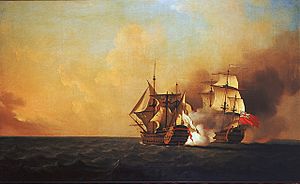
Massachusetts declared war in July 1722. The first battle of Father Rale's War in Nova Scotia happened then. New England launched a campaign to end the blockade and rescue prisoners. This led to the Battle at Jeddore. There was also a raid on Canso in 1723.
In July 1724, 60 Mi'kmaq and Maliseets raided Annapolis Royal. They killed soldiers, wounded others, and burned houses. They also took prisoners. The British responded by executing a Mi'kmaq hostage and burning three Acadian houses. Three blockhouses were built to protect the town.
In 1725, Abenakis and Mi'kmaq attacked Canso again. They destroyed two houses and killed six people. The treaty ending the war was important. It was the first time a European power formally agreed to negotiate its rule over Nova Scotia with the native people. This treaty was even used in a court case in 1999.
King George's War
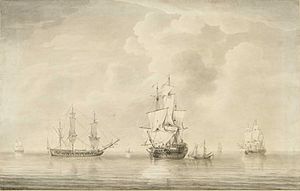
News of war reached the French Fortress of Louisbourg first in May 1744. This started King George's War. The French raided Canso and planned an attack on Annapolis Royal. But their Mi'kmaq and Maliseet allies attacked on their own in July. Annapolis was ready, and the Indigenous fighters left after a few days. A larger French force arrived later but could not attack effectively.
In 1745, British colonial forces captured Fortress Louisbourg after a six-week siege. France sent a large expedition to get Acadia back in 1746. But storms, disease, and the death of its commander, the Duc d'Anville, caused it to fail.
Father Le Loutre's War
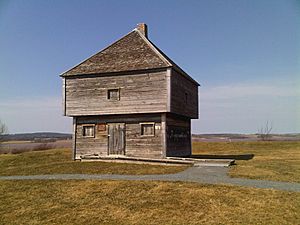
Even after the British took Port Royal in 1710, Nova Scotia was mostly home to Catholic Acadians and Mi'kmaq. To stop Protestant settlements, Mi'kmaq raided Shelburne (1715) and Canso (1720). Later, Father Le Loutre's War began when Edward Cornwallis arrived to establish Halifax in 1749.
The British built forts to protect new Protestant settlements from Mi'kmaq, Acadian, and French attacks. These forts were in Halifax (Citadel Hill), Bedford (Fort Sackville), Dartmouth, Lunenburg, and Lawrencetown. In Lunenburg, some settlers rebelled in 1753 due to poor conditions. There were many Mi'kmaq and Acadian raids on these villages, like the Raid on Dartmouth (1751).
Within 18 months, the British also built forts in major Acadian communities. These included Windsor (Fort Edward), Grand Pre (Fort Vieux Logis), and Chignecto (Fort Lawrence). Annapolis Royal already had a fort. There were many Mi'kmaq and Acadian raids on these forts, such as the Siege of Grand Pré.
Seven Years' War and Acadian Expulsion
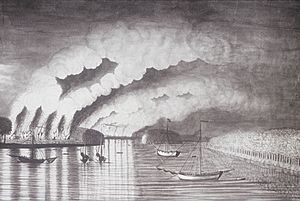
The last colonial war was the Seven Years' War. Acadians had refused to promise loyalty to Britain after the 1710 siege of Port Royal. They helped the French by fighting the British and supplying Louisbourg and Fort Beausejour.
During the Seven Years' War, the British wanted to remove the Acadians as a threat. They also wanted to stop the Acadians from supplying the French. So, they decided to deport the Acadians from Nova Scotia.
The British began the Expulsion of the Acadians in 1755. Over the next nine years, more than 12,000 Acadians were removed from Nova Scotia. During these deportations, Acadian and Native resistance against the British grew stronger.
British Deportation Campaigns
Bay of Fundy (1755)
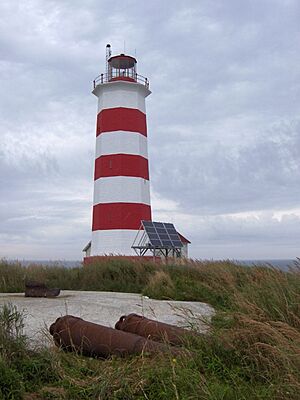
The first part of the expulsion began on August 10, 1755. The British ordered the Acadians to leave after the Battle of Fort Beauséjour in 1755. The campaign started at Chignecto. It then moved to Grand Pre, Piziquid (Falmouth/Windsor), and Annapolis Royal.
In November 1755, George Scott and 700 troops attacked Memramcook. They arrested Acadians and killed livestock to cut off French supplies. Many Acadians tried to escape by going to the St. John and Petitcodiac rivers, and Miramichi in New Brunswick. The British later cleared Acadians from these areas in 1758.
Cape Sable
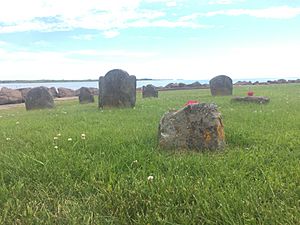
Cape Sable included Port La Tour and the surrounding area. In April 1756, Major Preble's troops raided a settlement near Port La Tour. They captured 72 people.
In 1758, Major Henry Fletcher led troops to Cape Sable. One hundred Acadians surrendered, while about 130 Acadians and seven Mi'kmaq escaped. The Acadian prisoners were taken to Georges Island in Halifax Harbour.
Later in 1758, Moncton sent Major Roger Morris to deport more Acadians. His troops sent women and children to Georges Island. The men were forced to destroy their village before being sent to Halifax. In 1759, Joseph Gorham and his rangers captured the remaining 151 Acadians.
Ile St. Jean and Ile Royale
The second part of the deportation began after the French lost the Siege of Louisbourg (1758). Thousands of Acadians were deported from Prince Edward Island and Cape Breton. The Ile Saint-Jean Campaign caused the most deaths among deported Acadians. Many died when the ships Violet and Duke William sank. By this time, the British sent Acadians directly to France, not the Thirteen Colonies. In 1758, hundreds of Acadians fled to refugee camps.
Petitcodiac River Campaign
British military operations took place from June to November 1758. They aimed to deport Acadians living along the Petitcodiac River or those who had taken refuge there. Benoni Danks and Joseph Gorham's Rangers carried out this operation.
On July 1, 1758, Danks pursued Acadians on the Petitcodiac. His Rangers ambushed about 30 Acadians near Moncton. Many were driven into the river, three were killed, and others captured. Danks became known as a "reckless and brutal" Ranger.
St. John River Campaign
Colonel Robert Monckton led 1150 British soldiers to destroy Acadian settlements along the Saint John River. They reached Sainte-Anne des Pays-Bas (present-day Fredericton) in February 1759. Monckton was joined by New England Rangers. The British started at the mouth of the river, raiding Kennebecais and Managoueche (Saint John). They built Fort Frederick there. Then they moved upriver, raiding Grimross, Jemseg, and Sainte-Anne des Pays-Bas.
Lieutenant Hazen and his Rangers burned the village of Sainte-Anne des Pays-Bas. They destroyed 147 buildings, two churches, barns, and stables. They also killed many animals. The Rangers tortured six Acadians and took six prisoners. One survivor, Joseph Godin-Bellefontaine, reported that the Rangers massacred his family in front of him.
Gulf of St. Lawrence Campaign
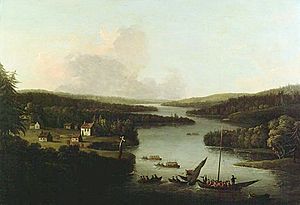
In this campaign, British forces raided French villages along the coasts of New Brunswick and the Gaspé Peninsula. Sir Charles Hardy and Brigadier-General James Wolfe led the forces. After the Siege of Louisbourg (1758), Wolfe and Hardy led 1500 troops to Gaspé Bay. From there, they sent troops to Miramichi Bay, Grande-Rivière, Pabos, and Mont-Louis. Over several weeks, Sir Charles Hardy destroyed about 200 fishing boats and took about 200 prisoners.
Restigouche
Acadians took refuge along the Baie des Chaleurs and the Restigouche River. Boishébert had a refugee camp at Petit-Rochelle. In late 1761, Captain Roderick Mackenzie captured over 330 Acadians at Boishebert's camp.
Halifax
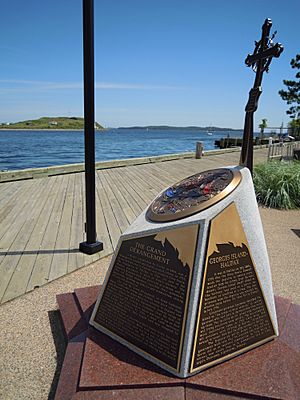
During this time, Halifax was further fortified with new batteries. After the French captured St. John's, Newfoundland, in June 1762, Acadians and Natives gathered in large numbers. They seemed confident and "insolent" to the British. Officials were worried when Natives gathered near Halifax and Lunenburg, where many Acadians also lived. The government deported 1300 people to Boston. But Massachusetts refused them entry and sent them back to Halifax.
Before the deportation, there were about 14,000 Acadians. Most were deported. Some escaped to Quebec or hid among the Mi'kmaq or in the countryside. The war ended, and Britain gained control of the entire Maritime region.
Acadian, Maliseet, and Mi’kmaq Resistance
During the expulsion, French Officer Charles Deschamps de Boishébert led the Mi'kmaq and Acadians in a guerrilla war against the British. By late 1756, the French regularly supplied 700 Native allies.
Annapolis (Fort Anne)
Acadians and Mi’kmaq fought in the Annapolis region. They won the Battle of Bloody Creek (1757). Acadians being deported from Annapolis Royal on the ship Pembroke rebelled. They took over the ship and sailed to land.
In December 1757, John Weatherspoon was captured by Indians near Fort Anne. He was taken to the Miramichi River, then sold to the French in Quebec. He was held until 1759.
About 50 or 60 Acadians who escaped the first deportation went to the Cape Sable region. From there, they raided Lunenburg many times.
Piziquid (Fort Edward)
In April 1757, Acadians and Mi'kmaq raided a warehouse near Fort Edward. They killed 13 British soldiers. They took supplies and burned the building. A few days later, they also raided Fort Cumberland. British officer John Knox wrote that the British only had "imaginary possession" of Nova Scotia. He said troops and people at Fort Edward, Fort Sackville, and Lunenburg were like "prisoners."
Chignecto (Fort Cumberland)

Acadians and Mi’kmaq also resisted in the Chignecto area. They won the Battle of Petitcodiac in 1755. In 1756, a wood-gathering party from Fort Monckton was ambushed. In April 1757, after raiding Fort Edward, the same group attacked Fort Cumberland. They killed two men and took two prisoners.
In July 1757, Mi'kmaq killed 23 of Gorham's rangers outside Fort Cumberland. In March 1758, Acadians and Mi'kmaq attacked a schooner at Fort Cumberland. They killed its master and two sailors. In 1759, Mi'kmaq ambushed five British soldiers near Fort Cumberland. Acadians and French captured a transport ship and chased another, the Moncton, down the Bay of Fundy.
Others resisted during the St. John River Campaign and the Petitcodiac River Campaign.
Lawrencetown
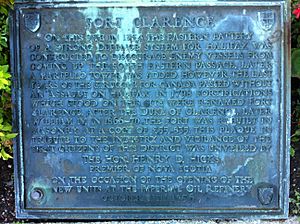
By June 1757, settlers had to leave Lawrencetown (established 1754). Too many Indian raids prevented them from leaving their homes.
In nearby Dartmouth, in 1759, Mi'kmaq attacked Eastern Battery. Five soldiers were killed.
Maine
In present-day Maine, the Mi’kmaq and Maliseet raided many New England villages. They attacked Gorham, New-Boston, Frankfort, and Sheepscot. They killed and captured settlers. In 1758, Indians raided Woolwich, Maine, killing and capturing the Preble family. This was the last conflict on the Kennebec River.
In August 1758, Boishebert left Miramichi, New Brunswick, with 400 soldiers. They marched to Fort St George and Munduncook. The siege of Fort St George failed. But in the raid on Munduncook, they wounded eight British settlers and killed others. This was Boishebert's last Acadian expedition. He and the Acadians then went to Quebec and fought in the Battle of the Plains of Abraham.
Lunenburg
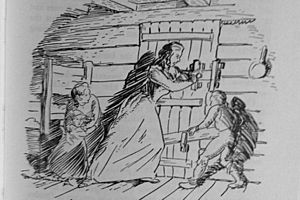
Acadians and Mi'kmaq raided the Lunenburg settlement nine times over three years. Boishebert ordered the first raid in 1756. In 1757, six people from the Brissang family were killed. In March 1758, five people were killed from the Ochs and Roder families on the Lunenburg Peninsula. By May 1758, most farmers on the peninsula left their farms for the safety of Lunenburg town.
During the summer of 1758, there were four raids on the Lunenburg Peninsula. In July, one person was killed and another wounded at Dayspring. In August, eight Mi'kmaq attacked homes in Mahone Bay, killing three people. Two days later, two soldiers were killed at a blockhouse in LaHave. In September, a child was killed. More raids happened in March and April 1759, killing more settlers.
Halifax
Acadian Pierre Gautier led Mi’kmaq warriors from Louisbourg on three raids against Halifax in 1757. In each raid, Gautier took prisoners. The last raid was in September. Gautier and four Mi’kmaq killed two British men at Citadel Hill.
In July 1759, Mi'kmaq and Acadians killed five Britons in Dartmouth.
Halifax Treaties
After many peace talks, the 75-year period of war ended with the Halifax Treaties between the British and the Mi'kmaq in 1761. Nova Scotians celebrate Treaty Day on October 1 to remember these treaties. To enforce the treaties, the British built more forts. The treaties said the Mi'kmaq would submit to the British and follow their laws. Some historians today say the treaties did not mean the Mi'kmaq surrendered. After these treaties, there were no more major troubles from the Mi'kmaq.
Halifax: North American Station Headquarters
Halifax was the main base for the Royal Navy's North American Station for 60 years (1758–1818). Halifax Harbour was a seasonal base since the city's founding in 1749. A permanent Naval Yard was bought in 1758 and opened in 1759. It was the main base for the British Royal Navy in North America during the Seven Years' War, the American Revolution, the French Revolutionary Wars, and the War of 1812. After 1818, Halifax became the summer base, with Bermuda as the winter base.
One famous commander was Robert Digby. After New York City surrendered in 1783, Digby helped move about 1,500 United Empire Loyalists to Conway, Nova Scotia. This settlement grew into a town, renamed Digby, Nova Scotia in 1787.
American Revolution
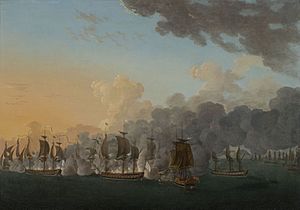
When the American Revolution began, many Nova Scotians were from New England. They felt sympathy for the American Patriots. But this support lessened as American Privateers attacked Nova Scotian villages and ships. They tried to stop Nova Scotian trade with Loyalists in New England. During the war, American Privateers captured 225 ships going to or from Nova Scotia ports.
Nineteenth Century Conflicts
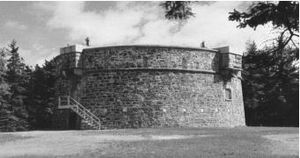
French Revolutionary Wars
Halifax became a strong British base on the East Coast of North America. Local merchants benefited from trade with the British Caribbean colonies. Growth really took off with the French Revolutionary Wars. Military spending and wartime trade boosted the economy. Famous privateers included Captain Alexander Godfrey of the Rover from Liverpool, Nova Scotia.
Conquest of Saint Pierre and Miquelon
In 1793, Brigadier General James Ogilvie led an expedition to conquer French-occupied Saint Pierre and Miquelon. He gathered ships and troops in Halifax. He also forced Halifax citizens to join the expedition. They captured Saint Pierre without a fight on May 14. They also captured 18 fishing boats and two American ships. They then captured Miquelon.
The French Prefect, Antoine-Nicolas Dandasne-Danseville, and hundreds of prisoners were brought to Halifax. Dandasne-Danseville was a prisoner until 1814. Governor John Wentworth wanted to house prisoners on Melville Island. But General Ogilvie objected and housed them at Cornwallis Barracks in Halifax. Some prisoners escaped, and the rest were sent to Guernsey in 1794.
Prince Edward Arrives
By 1796, Prince Edward, Duke of Kent, took command in Nova Scotia. He designed many of the city's forts. He left a lasting mark on Halifax with many public buildings. During his time, Halifax truly became a city. Landmarks like the Halifax Town Clock and St. George's Round Church were built. Fortifications were improved, businesses grew, and the population boomed.
Napoleonic Wars
Trafalgar Day
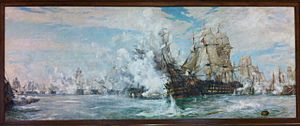
During the Napoleonic Wars, Trafalgar Day was celebrated in Nova Scotia on October 21. It honored Horatio Nelson’s victory over Napoleon in 1805. This battle was a major win for Britain at sea. Nova Scotians like John Houlton Marshall and George Augustus Westphal fought at Trafalgar. In 1905, Halifax had two days of celebrations for the battle's 100th anniversary.
Halifax Impressment Riot
Townspeople and sailors were always worried about the Royal Navy's "press gangs." These gangs forced men into naval service.
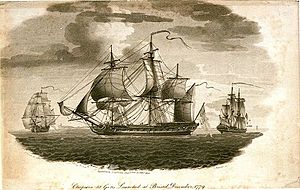
The Navy had trouble finding enough sailors in Nova Scotia in 1805. Many sailors deserted. In May, Vice Admiral Andrew Mitchell sent press gangs into Halifax. They rounded up many potential recruits.
In October 1805, press gangs from HMS Cleopatra stormed Halifax streets with bayonets. This caused a major riot. One man was killed, and several were injured. Governor Wentworth criticized the admiral for causing unrest. He used this event to put stricter rules on recruiting in Nova Scotia.
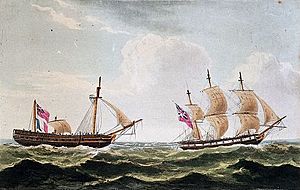
Relations between civilians and the Navy worsened from 1805 until the War of 1812. HMS Whiting terrorized Liverpool and Shelburne by pressing people, breaking into homes, and forcing families to hide in the forest.
Invasion of Martinique (1809)
Lieutenant Governor of Nova Scotia George Prévost led the British Navy from Halifax for the Invasion of Martinique (1809). They left Halifax in December 1808. Martinique was captured, and Prévost returned to Halifax in April 1809. The town celebrated his victory. The House of Assembly voted to buy Prévost a sword to honor his actions. Three soldiers died in the invasion and are remembered with a plaque in St. George's Round Church. Prévost became a popular lieutenant governor.
War of 1812
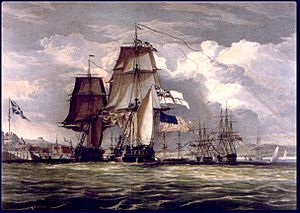
Before the War of 1812, the Little Belt incident caused excitement in Nova Scotia. In 1811, the British ship Little Belt arrived in Halifax with many killed or wounded after being attacked by an American ship. At the start of the war, Nova Scotia was worried when USS Constitution defeated HMS Guerriere, which had just left Halifax.
During the War of 1812, Nova Scotia helped by buying or building privateer ships. These ships captured American vessels. The privateer schooner Lunenburg captured seven American ships. The Liverpool Packet from Liverpool, Nova Scotia, captured over 50 ships, more than any other Canadian privateer. Sir John Sherbrooke was also very successful.
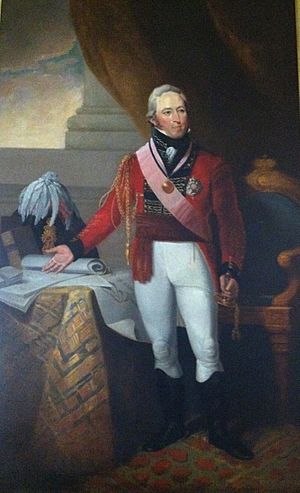
A dramatic moment was when HMS Shannon led the captured American frigate USS Chesapeake into Halifax Harbour in 1813. The captain of Shannon was injured. Nova Scotian Provo Wallis took command to escort Chesapeake to Halifax. Many prisoners were kept at Deadman's Island.
In September 1814, a British fleet from Halifax, Nova Scotia, besieged Maine. They wanted to reclaim Maine east of the Penobscot River, calling it "New Ireland." This had been a British goal since the American Revolution. The expedition captured Castine, Maine, and raided other towns. After the war, Maine was returned to America. The customs money from "New Ireland" was used to fund a military library in Halifax and start Dalhousie University.
The most famous soldier buried in Nova Scotia during the war was Robert Ross (British Army officer). Ross was responsible for burning Washington, including the White House.
Crimean War
Nova Scotians fought in the Crimean War. The Sebastopol Monument in Halifax is the fourth oldest war monument in Canada. It's the only Crimean War monument in North America. Another Nova Scotian soldier who fought bravely was Sir William Williams, 1st Baronet, of Kars.
After the Crimean War, the Victoria Rifles (Nova Scotia) (1860) were formed. This was the second Black military unit in Canada. One Halifax resident named his home Alma Villa after the Battle of Alma.
Indian Mutiny
Nova Scotians also took part in the Indian Mutiny from 1857 to 1858. Two famous Nova Scotians were William Hall (VC) and Sir John Eardley Inglis. Both fought in the Siege of Lucknow. The 78th (Highlanders) Regiment of Foot was famous for its role in the siege. They were later stationed at Citadel Hill.
American Civil War
Over 200 Nova Scotians fought in the American Civil War (1861–1865). Most joined Union (North) regiments. About one in ten served the Confederacy (South). Many young men had moved to the U.S. before 1860, so the total number was likely higher. Some Nova Scotians were against the war, but others strongly supported ending slavery. Many were also drawn by the adventure and money. Famous Nova Scotians who fought include Charles Robinson (Medal of Honor), Joseph B. Noil, Robert Knox Sneden, Benjamin Jackson, and John Taylor Wood. Three Black Nova Scotians served in the famous 54th Massachusetts Infantry Regiment.
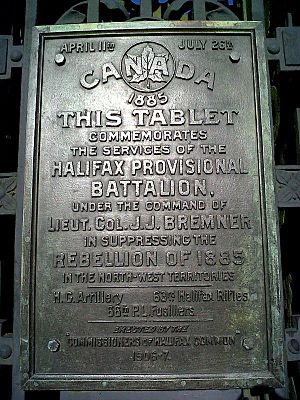
The British Empire, including Nova Scotia, stayed neutral. Nova Scotia benefited greatly from trade with the North. There were no attempts to trade with the South. Nova Scotia had two minor incidents during the war: the Chesapeake Affair and the escape of the CSS Tallahassee from Halifax Harbour.
The war made many fear that the North might try to take over British North America. This fear grew after the Fenian raids began. Volunteer regiments were formed across Nova Scotia. British commander and Lieutenant Governor of Nova Scotia Charles Hastings Doyle led 700 troops from Halifax to stop a Fenian attack on the New Brunswick border. This scare was a main reason Britain allowed Canada to be created in 1867. This way, Canada would be responsible for defending Nova Scotia.
North-West Rebellion
The Halifax Provisional Battalion was a military unit from Nova Scotia. It was sent to fight in the North-West Rebellion in 1885. The battalion had 168 non-commissioned officers and men from The Princess Louise Fusiliers, 100 from the 63rd Battalion Rifles, and 84 from the Halifax Garrison Artillery, with 32 officers. They left Halifax on April 11, 1885, and stayed for almost three months.
Before this, Nova Scotia was still unhappy about being forced into Canada. But the celebration when the Halifax Provisional Battalion returned sparked national pride in Nova Scotia. Prime Minister Robert Borden said the rebellion helped unite Nova Scotia with the rest of Canada. In 1907, Governor General Earl Grey said, "This Battalion... went out Nova Scotians, they returned Canadians." The wrought iron gates at the Halifax Public Gardens were made in the Battalion's honor.
Twentieth Century Conflicts
Second Boer War
During the Second Boer War (1899–1902), the first group of Canadian soldiers included a Nova Scotia Company of 125 men. The total force was 1,019. Eventually, over 8,600 Canadians served. They sailed to Cape Town in October 1899.
The Boer War was the first time many Nova Scotian troops served abroad. Canadians fought in the Battle of Paardeberg in February 1900. They also saw action at the Battle of Faber's Put. In November 1900, the Royal Canadian Dragoons saved British guns from capture.
About 267 Canadians died in the war. Most died from disease. The most famous Nova Scotian casualty was young Lieutenant Harold Lothrop Borden. His father was Canada's Minister of Militia. Another famous Nova Scotian who died was Charles Carroll Wood, the first Canadian to die in the war.
For two decades, Canadians gathered on February 27 (Paardeberg Day) to honor veterans. This continued until the end of World War I, when Remembrance Day began on November 11.
First World War
The Prime Minister of Canada during the war was Nova Scotian Robert Borden. For the war effort, 39 units were raised in Nova Scotia. This included 30,000 soldiers from a population of 550,000.
During World War I, Halifax became a major international port and naval base. The harbor was a key shipping point for war supplies and troops to Europe. It also received hospital ships with wounded soldiers. This led to a big military, industrial, and residential expansion of the city.
On June 27, 1917, a German U-boat torpedoed a hospital ship from Halifax called HMHS Llandovery Castle. The U-boat pursued and sank lifeboats, machine-gunning survivors. Only 24 of 258 crew members survived. The ship's commander, Lt.-Col. Thomas Howard MacDonald, and the nursing Matron, Margaret Marjory Fraser, were from Nova Scotia. They both died, along with 13 nurses.
On December 6, 1917, Halifax was devastated by the Halifax Explosion. A French cargo ship full of explosives collided with a Norwegian ship in Halifax Harbour. About 2,000 people were killed by debris, fires, or collapsed buildings. Over 9,000 people were injured. This is still the world's largest accidental non-nuclear explosion.
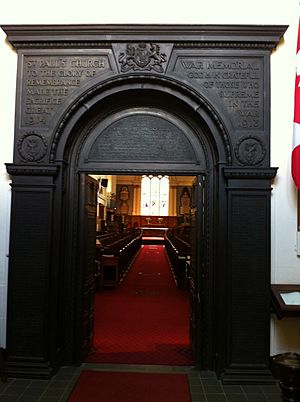
Founders of the League of Nations, David Ben-Gurion (who became Israel's first prime minister) and Ze'ev Jabotinsky, trained at Fort Edward. Ben-Gurion later said, "I will never forget Windsor where I received my first training as a soldier and where I became a corporal."
The Amherst Internment Camp was one of three internment camps in Nova Scotia. It was the largest POW camp in Canada during World War I. A maximum of 853 prisoners were held there. The most famous prisoner was Leon Trotsky.
Three Nova Scotian battalions fought in Europe as distinct units: The Royal Canadian Regiment, the 85th Battalion, and the 25th Battalion. The Royal Canadian Regiment was the only unit already in existence when the war started.
The 36th Battery, Canadian Field Artillery, was formed in Sydney, Cape Breton, in 1915. The No. 2 Construction Battalion was the only mostly Black battalion in Canadian military history. It was also the only Canadian Battalion of Black soldiers to serve in World War I. 56% of the battalion (500 soldiers) were from Nova Scotia.
Spanish Civil War
The Communist Party of Canada encouraged people to join the Mackenzie-Papineau Battalion. They fought against the Nationalists in the Spanish Civil War. Joining was illegal under Canadian law. Despite this, 19 volunteers from Nova Scotia joined. About 1,500 Canadians volunteered, and half were killed. Perhaps the best-known Nova Scotian was Roy Leitch, a Dalhousie University professor. He later published a controversial newspaper. In February 1939, 421 returning soldiers from the Battalion arrived in Halifax. The last Nova Scotian veteran of the "Mac-Paps" died in the 1980s. The Canadian Government has never officially recognized these veterans.
Second World War
During World War II, thousands of Nova Scotians went overseas. Nova Scotian Mona Louise Parsons joined the Dutch resistance. She was captured and imprisoned by the Nazis for almost four years. Another Nova Scotian, William M. Jones, was part of the resistance in Yugoslavia.
From 1939 until VE Day, several of Canada's Atlantic ports became vital for supplying the United Kingdom and the Allies. Halifax and Sydney, Nova Scotia, became the main convoy assembly ports. Halifax handled fast convoys (troops and essential materials), while Sydney handled slow convoys (bulkier materials on older ships). Both ports were heavily fortified with radar, searchlights, and coastal artillery. Military intelligence enforced strict blackouts. Anti-torpedo nets were placed at harbor entrances. German U-boats frequently attacked convoys leaving for Europe.

The Battle of the St. Lawrence was less damaging to the war effort but affected Canadian morale. U-boats began attacking Canadian coastal shipping in the St. Lawrence River and Gulf of St. Lawrence from 1942 to 1944.
SS Caribou was a ferry that ran between Newfoundland and North Sydney, Nova Scotia. It was sunk by German submarine U-69 in October 1942. As a civilian ship, it had women and children on board. Many of the 137 who died were civilians. Its sinking made it clear that the war had reached Canada's home front. It is seen as the most significant sinking in Canadian-controlled waters during World War II. In the Cabot Strait, HMCS Shawinigan was torpedoed and sunk with all 85 crew members by U-1228 in November 1944.
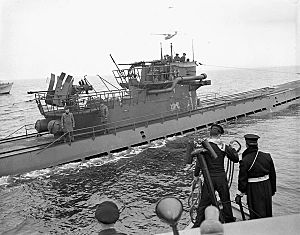
In both World Wars, German submarines torpedoed Allied ships near Sambro Island Light. In World War II, HMCS Clayoquot was hit by a torpedo from U-806 in December 1944. It sank quickly, and eight lives were lost. In April 1945, U-190 sank HMCS Esquimalt near Halifax, killing 44 crew.
Several Royal Navy escorts were attached to the Royal Canadian Navy for convoys in the St. Lawrence. Royal Canadian Air Force (RCAF) aircraft patrolled from various stations. At Camp Hill Cemetery, there are 17 graves of Norwegian sailors, soldiers, and merchant seamen who died in Nova Scotia during World War II. These men were at sea when Germany invaded Norway. Camp Norway was established at Lunenburg.
Leonard W. Murray was born in Granton, Nova Scotia. Rear Admiral Murray was an officer in the Royal Canadian Navy. He played a big role in the Battle of the Atlantic. He commanded the Newfoundland Escort Force and later the Canadian Northwest Atlantic. He was the only Canadian to command an Allied theatre of operations in either World War. He resigned after the Halifax VE-Day Riot.
In May 1945, after Germany surrendered, U-889 surrendered to the Royal Canadian Navy at Shelburne, Nova Scotia.
Korean War
During the Korean War, 48 Nova Scotians died, and over 100 were wounded. The only Nova Scotian from the Royal Canadian Navy to die was Robert John Moore. He was killed in an air crash. He is remembered on the Korean War Memorial at the Naval Museum of Alberta.
Afghanistan
Thirteen Nova Scotians were among the 158 Canadians killed in the Afghanistan War.
Notable Nova Scotian Military Figures
This list includes people born in Nova Scotia, Acadia, and Mi'kma'ki, or those who became citizens.
17th-18th Centuries
-
Jacques Testard de Montigny – King William's War
-
Father Sébastien Rale – Dummer's War
-
Captain Charles Morris – King George's War
-
John Bradstreet – King George's War
-
Father Pierre Maillard – Father Le Loutre's War
-
Joseph Frederick Wallet DesBarres – Seven Years' War
-
Major General John Small, Commander, 84th Regiment of Foot (Royal Highland Emigrants) – American Revolution
-
Francis McLean – American Revolution
- Charles de Saint-Étienne de la Tour – Acadian Civil War
- Chief Madockawando – King William's War
- John Gyles – King William's War
- Father Louis-Pierre Thury – King William's War
- Pierre Maisonnat dit Baptiste – Queen Anne's War
- Robert Denison – King George's War
- Joseph-Nicolas Gautier – Father Le Loutre's War
- Pierre II Surette – Seven Years' War
- John Allan (colonel) – American Revolution
- Benjamin Belcher – American Revolution
19th Century
-
Commander John Houlton Marshall – Battle of Trafalgar, Province House (Nova Scotia)
-
George Augustus Westphal – Battle of Trafalgar, Admiralty Garden, Stadacona, CFB Halifax, Nova Scotia
-
Sir John Coape Sherbrooke – Lt Gov. of Nova Scotia – War of 1812
-
John Charles Beckwith (army officer) – Battle of Waterloo
-
Capt. Herbert Clifford – Invasion of Isle de France
-
Edward Belcher – Franklin's lost expedition
-
Sir William Williams, 1st Baronet, of Kars by William Gush – Crimean War
-
Major Augustus F. Welsford – Crimean War
-
Captain William B.C.A. Parker – Crimean War
-
Nova Scotian Sir John Eardley Inglis by William Gush – Indian Mutiny
-
William Hall (VC) – Indian Mutiny
-
Robert Knox Sneden – American Civil War
-
Clonard Keating – Nigeria, Plaque, Halifax Public Gardens, Nova Scotia
20th Century
-
Harold Lothrop Borden – Second Boer War, Borden Monument, Canning, Nova Scotia
-
Francis Joseph Fitzgerald – Second Boer War, Fitzgerald Bridge in Halifax Public Gardens
-
Margaret Marjory Fraser – World War I
-
Walter Harris Callow – World War I, disabled veterans advocate
-
Philip Bent, VC – World War I
-
Jeremiah Jones – WW 1
-
Sam Gloade – WW1
-
Reverend William A. White – WW1
-
Roy Leitch – Spanish Civil War
-
Mona Louise Parsons – World War II
-
Leonard W. Murray – World War II
-
Desmond Piers – World War II
- William M. Jones
- Ransford D. Bucknam
- Edward Francis Arab
Nova Scotian Victoria Cross Recipients
This along with the *, indicates that the Victoria Cross was awarded posthumously
| Name | Date of action | Conflict | Unit | Place of action | Province of origin | Notes |
|---|---|---|---|---|---|---|
| Philip Bent | 1917* | First World War | The Leicestershire Regiment | Polygon Wood, Belgium | Nova Scotia | |
| John Croak | 1918* | First World War | 13th Battalion, CEF | Amiens, France | Nova Scotia | |
| William Hall | 1857 | Indian Mutiny | HMS Shannon | Lucknow, India | Nova Scotia | |
| John Kerr | 1916 | First World War | 49th Battalion, CEF | Courcelette, France | Nova Scotia | |
| James Robertson | 1917* | First World War | 27th Battalion, CEF | Passchendaele, Belgium | Nova Scotia |
Communities and Streets Named After Military Figures and Battles
King George's War
- Shirley St., Halifax, William Shirley
- Pepperell St., Halifax William Pepperell
- Mascarene Ave., Halifax, Paul Mascarene
Father Le Loutre's War
- Port Hawkesbury, Edward Hawke, 1st Baron Hawke
- Morris St., Halifax, Charles Morris (jurist)
- Lawrencetown, Nova Scotia, Charles Lawrence
- Cornwallis, Nova Scotia, Edward Cornwallis
- Cornwallis St., Halifax, Edward Cornwallis
Seven Years' War
- Amherst, Nova Scotia, Jeffery Amherst
- Cumberland County, Nova Scotia, Prince William, Duke of Cumberland
- Montague St., Lunenburg, Nova Scotia, Montague Wilmot
American Revolution
- Belcher Street, Port Williams, Nova Scotia, Lieut. Benjamin Belcher, hero of Battle of Blomindon
- Guysborough, Nova Scotia (Guy's borough), Guy Carleton, 1st Baron Dorchester
- Carleton Corner
- Carleton Village, Nova Scotia
- Birchtown, Nova Scotia, Brigadier-General Samuel Birch, compiler of the Book of Negroes
- Rawdon, Nova Scotia, Francis Rawdon-Hastings
- Digby, Nova Scotia, Admiral Robert Digby (Royal Navy officer)
- Abercrombie, Nova Scotia, General James Abercrombie
- Tiddville, Nova Scotia, Samuel Tidd, a private for Col. Beverley Robinson
- Gilbert Cove, Nova Scotia, Lt. Thomas Gilbert
- Barton, Nova Scotia, Lt. Col. Joseph Barton (military officer)
- Russell Lake, Nova Scotia, Nathaniel Russell
- Parrsboro, Nova Scotia, John Parr
- Wentworth, Nova Scotia, Sir John Wentworth, 1st Baronet
- Wentworth Valley, Nova Scotia
- Wentworth Station, Nova Scotia
- Douglas, Nova Scotia, Sir Charles Douglas, 1st Baronet
Napoleonic Wars
- Port Hood, Nova Scotia
- Westphal, Nova Scotia, George Augustus Westphal
- Castine Way, Dalhousie University, Halifax, Battle of Hampden
- Provo Wallis St., Halifax Dockyard, Provo Wallis
- Martinique, Nova Scotia, Invasion of Martinique (1809)
- Waterloo St. Halifax, Battle of Waterloo
- Wellington, St., Halifax, Arthur Wellesley, 1st Duke of Wellington
- Sherbrooke, Nova Scotia, John Coape Sherbrooke
- Admiral Rock, Nova Scotia, Admiral Alexander Cochrane
- Lake Ainslie, Ainslieview, Nova Scotia and Ainslie Point, Nova Scotia, George Robert Ainslie
- Kempt Shore, Nova Scotia, James Kempt
- Kempt Road, Nova Scotia
- Kempt Road, Halifax, Nova Scotia
- Kempt Street, Lunenburg
Crimean War
- Lucknow St., Halifax, Siege of Lucknow
- Inglis St., Halifax, John Eardley Inglis
- Havelock, Nova Scotia, Henry Havelock
- Karsdale, Nova Scotia, Sir William Williams, 1st Baronet, of Kars
- Port Williams, Nova Scotia, Sir William Williams, 1st Baronet, of Kars
- Parker St., Halifax, Sebastopol Monument
- Welsford St., Halifax, Sebastopol Monument
- Welsford St., Pictou, Nova Scotia
- Alma, Nova Scotia, Battle of Alma
American Civil War
- Ben Jackson Road (exit 8A Highway 101), Benjamin Jackson (soldier)
- Port Hastings, Nova Scotia, Charles Hastings Doyle
Boer War


